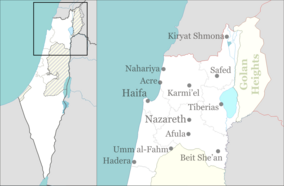| Revision as of 22:52, 16 March 2013 editYobot (talk | contribs)Bots4,733,870 editsm WP:CHECKWIKI error fixes using AWB (8976)← Previous edit |
Latest revision as of 05:18, 13 November 2024 edit undoHerniac (talk | contribs)Extended confirmed users1,879 edits Added short descriptionTags: Mobile edit Mobile app edit Android app edit App description add |
| (32 intermediate revisions by 20 users not shown) |
| Line 1: |
Line 1: |
|
|
{{Short description|Intermittent stream in Israel}} |
|
] |
|
|
|
{{Infobox protected area |
| ⚫ |
'''Nahal Betzet''' ({{lang-he|נחל בצת}}, {{lang-ar|''Wadi Karkara''}}) (lit. "Betzet stream") is a once-] and now ] in the ], ]. |
|
|
|
| name = Nahal Betzet Nature Reserve |
|
|
| alt_name = שמורת נחל בצת |
|
|
| iucn_category = |
|
|
| photo = KeshetCaveByAviv.JPG |
|
|
| photo_alt = |
|
|
| photo_caption= The arch known as Keshet Cave (Rainbow Cave), the remains of a large collapsed cave |
|
|
| map = Israel north haifa |
|
|
| location = ], ] |
|
|
| nearest_city = ] |
|
|
| coordinates = {{coord|33.0728|N|35.2144|E|source:wikidata-and-enwiki-cat-tree_region:IL|display=inline,title}} |
|
|
| area = {{convert|7650|dunam}} |
|
|
| established = 1972 |
|
|
| visitation_num = |
|
|
| visitation_year = |
|
|
| governing_body = ] |
|
|
}} |
|
⚫ |
'''{{lang|he-Latn|Nahal Betzet|italic=no}}''' ({{langx|he|נחל בצת}}, lit. "Betzet stream"; {{langx|ar|وادي كركرة}}, '''{{lang|ar-Latn|Wadi Karkara|italic=no}}'''), is a once-] and now ] in the ], ]. Most of it is part of the ] named for the stream. |
|
|
|
|
|
==Geography== |
|
==Geography== |
|
⚫ |
The stream crosses the border from ] into Israel between ] and ], and flows westward, emptying into the ] south of ]. The stream runs along a ] through ] and ], and is fed along its course by ]. Currently, ] (the national water company) pumps the water of the stream's springs, and has been accused of causing the stream to dry up.<ref>{{cite web|url=http://www.inature.info/%D7%A9%D7%9E%D7%95%D7%A8%D7%AA_%D7%A0%D7%97%D7%9C_%D7%91%D7%A6%D7%AA|title=Nahal Betzet Nature Reserve|language=Hebrew|accessdate=2010-10-05|publisher=iNature.info}}</ref> Many caves are formed on the banks of the stream, most notably the arch known as ] (Rainbow Cave). |
|
] |
|
| ⚫ |
The stream crosses the border from ] into Israel between ] and ], and flows westward, emptying into the ] south of ]. The stream runs along a ] through ] and ], and is fed along its course by ]. Currently, ] (the national water company) pumps the water of the stream's springs, and has been accused of causing the stream to dry up.<ref>{{cite web|url=http://www.inature.info/%D7%A9%D7%9E%D7%95%D7%A8%D7%AA_%D7%A0%D7%97%D7%9C_%D7%91%D7%A6%D7%AA|title=Nahal Betzet Nature Reserve|language=Hebrew|accessdate=2010-10-05|publisher=iNature.info}}</ref> Many caves are formed on the banks of the stream, most notably the Keshet Cave. |
|
|
|
|
|
|
==Nature reserve== |
|
==Nature reserve== |
|
Most of the stream is part of a nature reserve that bears its name.<ref>{{cite web|url=http://www.protectedplanet.net/sites/Nahal_Bezet_Nature_Reserve|title=Nahal Betzet Nature Reserve|publisher=ProtectedPlanet.com}}</ref> The reserve, declared in 1972 covers 7650-]<ref>{{cite web|title=List of National Parks and Nature Reserves|url=http://parks.org.il/sigalit/muchrazim.pdf|language=Hebrew|publisher=Israel Nature and Parks Authority|accessdate=2010-09-27}}</ref> and part of it reaches the Israel-Lebanese border. In 2009, 1225 dunams were added to the reserve. |
|
Most of the stream is part of a nature reserve that bears its name.<ref>{{cite web|url=http://www.protectedplanet.net/sites/Nahal_Bezet_Nature_Reserve|title=Nahal Betzet Nature Reserve|publisher=ProtectedPlanet.com}}</ref> The reserve, declared in 1972 covers 7650-]<ref>{{cite web|title=List of National Parks and Nature Reserves|url=http://parks.org.il/sigalit/muchrazim.pdf|language=Hebrew|publisher=Israel Nature and Parks Authority|accessdate=2010-09-27|url-status=dead|archive-url=https://web.archive.org/web/20091007095221/http://parks.org.il/sigalit/muchrazim.pdf|archive-date=2009-10-07}}</ref> and part of it reaches the Israel-Lebanese border. In 2009, 1225 dunams were added to the reserve. |
|
|
|
|
|
Flora in the area includes '']'', '']'', and '']''. |
|
Flora in the area includes '']'', '']'', and '']''. |
|
|
== Gallery == |
|
|
<gallery> |
|
|
File:PikiWiki Israel 87799 betzet river.jpg|Nahal Betzet |
|
|
File:Nahal Betzet (997009157460805171.jpg|Ruins at Nahal Betzet, identified as Khirbet Karkara, an archaeological site in Israel. |
|
|
File:PikiWiki Israel 87795 betzet river.jpg|Sarach Cave, a stalactite cave home to insect-eating bats, where visitors are advised not to disturb the bats. |
|
|
</gallery> |
|
|
|
|
|
==See also== |
|
|
*] |
|
|
|
|
|
==References== |
|
==References== |
|
{{reflist}} |
|
{{Reflist}} |
|
|
|
|
|
==External links== |
|
==External links== |
|
* |
|
* |
|
* |
|
* |
|
⚫ |
{{Streams of the Galilee}}{{Nature reserves of Israel}} |
|
|
|
|
|
{{Authority control}} |
|
{{coord missing|Israel}} |
|
|
|
{{commons category|Nahal Betzet}} |
|
|
|
| ⚫ |
{{Nature reserves of Israel}} |
|
|
|
|
|
|
{{DEFAULTSORT:Betzet, Nahal}} |
|
{{DEFAULTSORT:Betzet, Nahal}} |
|
] |
|
] |
|
] |
|
] |
|
|
] |
|
|
|
|
] |
|
|
] |
|
Most of the stream is part of a nature reserve that bears its name. The reserve, declared in 1972 covers 7650-dunam and part of it reaches the Israel-Lebanese border. In 2009, 1225 dunams were added to the reserve.
 The arch known as Keshet Cave (Rainbow Cave), the remains of a large collapsed cave
The arch known as Keshet Cave (Rainbow Cave), the remains of a large collapsed cave
 Nahal Betzet
Nahal Betzet
 Ruins at Nahal Betzet, identified as Khirbet Karkara, an archaeological site in Israel.
Ruins at Nahal Betzet, identified as Khirbet Karkara, an archaeological site in Israel.
 Sarach Cave, a stalactite cave home to insect-eating bats, where visitors are advised not to disturb the bats.
Sarach Cave, a stalactite cave home to insect-eating bats, where visitors are advised not to disturb the bats.